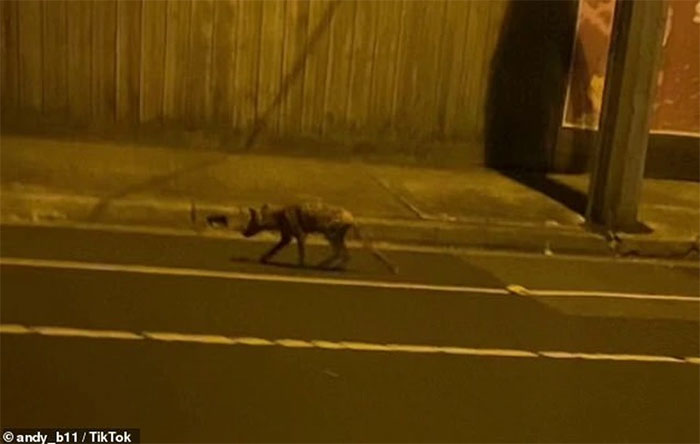A creature resembling the Tasmanian tiger was spotted roaming the streets of Melbourne, Australia, startling local residents.
On September 7, 1936, the last known Tasmanian tiger died in captivity at the Beaumaris Zoo in Hobart, Australia. However, recently, images of a thin, gray creature with a long tail and spotted fur, suspected to be a Tasmanian tiger, running along a road in the northwestern suburbs of Strathmore, Melbourne, have surfaced on social media, surprising many.
The TikTok account andy_b11, which shared the video, questioned whether the creature could be the long-extinct Tasmanian tiger. The man chased the animal to record the video before it escaped into the bushes by the roadside. The strange creature featured in the video displayed black stripes on its back, resembling the distinctive characteristics of the Tasmanian tiger.
Netizens quickly commented on the mysterious creature. “It’s a bit small, doesn’t look like a Tasmanian tiger, more like a fox,” “I’m sure Tasmanian tigers are larger than that,” “It looks like a starving dog,” “The animal has a sturdy tail, thick at the base, with vertical stripes along its back,” “It’s about the size of an Australian Kelpie dog,” some comments noted.

The creature believed to be a Tasmanian tiger with almost identical physical characteristics.
Despite having “tiger” in its name, the Tasmanian tiger is actually a member of the carnivorous marsupial family Thylacine, also known as the Tasmanian wolf due to its dog-like appearance—especially its head. They have a brownish-yellow coat with black stripes at the end of their back and tail.
Unlike most other marsupials, both male and female Tasmanian tigers possess pouches. Their scientific name is Thylacinus cynocephalus, which translates to “dog-headed marsupial.” Additionally, Tasmanian tigers have tails that are stiff like a kangaroo’s and very short legs. They possess sharp teeth, ranging from 40 to 50, and can live up to 7 years in the wild.
This species is known for its solitary hunting habits and is typically nocturnal, communicating with each other through hoarse barks or sounds “similar to a terrier,” some sources report.
According to American scientist Richard K. Nelson, “The Thylacine is one of the most unique animals on Earth—they’re called tigers, but they resemble kangaroos and have been shaped by evolution to look like dogs.”
This creature was first found in Australia and Papua New Guinea, but it gradually disappeared from the Australian mainland around 2,000 to 200 years ago.
Tasmanian tigers are shy creatures and are easily captured due to their isolated living conditions and the absence of human presence during their development, which did not allow them to develop a fear of humans.
The prey of Tasmanian tigers typically includes kangaroo rats, wombats, and occasionally sheep and livestock. Their tendency to hunt livestock made them a “thorn” in the eyes of British settlers who arrived in Tasmania in 1803.
The consequence was that the wild Tasmanian tigers were hunted to extinction by humans. Initially, the indigenous people did not know much about this species and even feared that they would attack humans. However, in reality, they lived hidden in nature and tended to avoid human encounters.
Since this species went extinct in 1936, the Tasmania Parks and Wildlife Service has investigated over 400 reported sightings of Tasmanian tigers, but no substantial evidence has been presented.
Australian scientists even plan to recreate the extinct Tasmanian tiger from genes found in their bones and teeth at museums. However, this effort has not yet succeeded due to the very low genetic diversity of the Tasmanian tiger.


















































